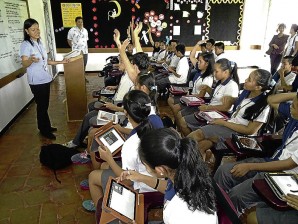
SOPHOMORE students of the Foundation University High School learn through e-books as Victor Vicente Sinco, FU vice president for finance and administration, (2nd from left), the main proponent of the iPad program, observes. Alex Pal
Imagine a Philippine classroom where students do not anymore use thick, paperbound books. Instead, before each student and the teacher is an iPad.
No, this is not a picture of a classroom of the future. It’s happening now at Foundation University (FU) in Dumaguete City.
The iPad is Apple’s revolutionary handy tablet computer, which has become a popular platform for audio-visual media including books, periodicals, movies, music, games and web content.
Through this device, sophomore high school students are learning through digitized Philippine textbooks from Vibal Publishing House Inc., which also started producing e-books for this school year.
“It was a wonderful coincidence,” said Victor Vicente Sinco, FU vice president for finance and administration.
The university prepared to start the program this year where only Math, English and Science would be taught using the iPad. But in the process, one of the students stumbled upon Vibal Publishing’s latest innovation.
The university then asked Vibal Publishing permission to be the first Philippine school to use their e-books for iPads. The company immediately sent their software experts to Dumaguete to brief the teachers on how to use the e-books.
Hawon Roh, 14, a Korean student, said he was excited with the touch-screen features of the iPad, which he says makes learning more exciting.
Filipino teacher Venicar Eltanal, on the other hand, said the interactive features of the e-books make students more interested in class.
Mac users
Foundation University, a 62-year-old nonstock, nonprofit, nonsectarian institution, is no stranger to technological innovations being the largest Mac user outside of Manila.
“We easily have 300 machines for students only, not counting the offices. To count the total number of Macs at FU, either university or personally owned units, would easily top 400,” Sinco said.
Sinco, whose love for Macs started when he was an associate at AM Partners Inc. in Hawaii in the mid 1980s, said the university is removing PCs and replacing them with Macs, just like what President Barack Obama did when he first entered the White House.
The iPad has been a great help for Sinco, an itinerant architect and educator, who spends half of the year in the Philippines and the other half in Hawaii.
“I primarily purchased it for mobility. In the beginning, it was good for e-mail but I found out that I could edit architecture designs on the iPad and e-mail it back to the office. No time was lost.”
Educational apps
Educational applications on the iPad are also on the rise.
“I also discovered all the apps like TedTalks. If you have a 3G connection, you can access these webinars everywhere. As a tool for continuing education for professionals, it’s valuable because you don’t have to be in the classroom.”
Sinco also makes it a habit to check the blogsites of computers daily.
“There were more and more articles from people realizing what kind of valuable tool the iPad could be in education and I would e-mail all these articles to the faculty here at Foundation so that awareness would grow.”
“We have a whole year of experience and each experience solidifies our conviction that an iPad is a good tool to have, to a point that we think: where would we be without it?”
Sinco brought the first iPads in Dumaguete last year, giving them to administrators on soft loan to experiment with learning tools.
They found that using the iPad was more convenient than the laptop computer.
Sinco’s mother and FU president, Mira Sinco, was so excited with the new device that she stayed up until 2 a.m. on the first day to explore its capabilities.
Since then, Foundationites saw more and more iPads being used by their teachers, classmates and friends. Even the university carpenters have one iPad among themselves to enable them to watch videos to improve their craft.
So convinced was the university about this program that it actually braced itself for a drop in enrollment because of this new requirement.
“I told the teachers not to worry if enrollment went down. We had to make this work to prove to the parents that their children would actually become smarter through the iPad program,” Sinco said.
True enough, a lot of concerns had been raised by parents of the sophomore high school students who, apart from paying tuition, now found themselves having to fork out around P27,000 for an iPad.
Surpassed expectations
Mary Rose Acupanda, high school principal, said the administration answered the questions during a PTA meeting last month. “In the end, they saw the wisdom of using the iPad, which was one of the requirements for enrollment.”
The university was later surprised to learn that enrollment actually surpassed expectations.
In a local cable TV talk show in July where the university explained the iPad program, inquiries were sent by SMS inquiring if they could still enroll their children at FU.
Jane Borromeo, a mother of first year student Ma. Antonette, said she and her husband Glenn were easily convinced about the iPad program that they got their daughter an iPad on her first year so she could familiarize herself with the device.
With the initial favorable reviews that this program has been getting, the plan is to expand the iPad program to the sophomore and junior high school students next year.
Sinco said the program could be expanded to other grades if the PTA wants it.
After all, with a whole lineup of textbooks available from kindergarten to Grade 12, making the shift toward total e-learning could simply happen with the push of a button.

